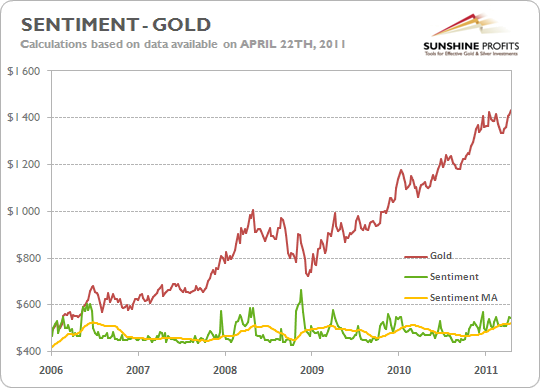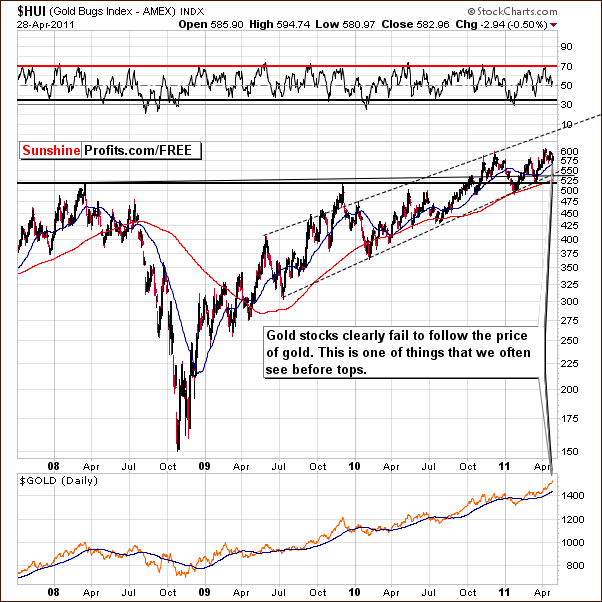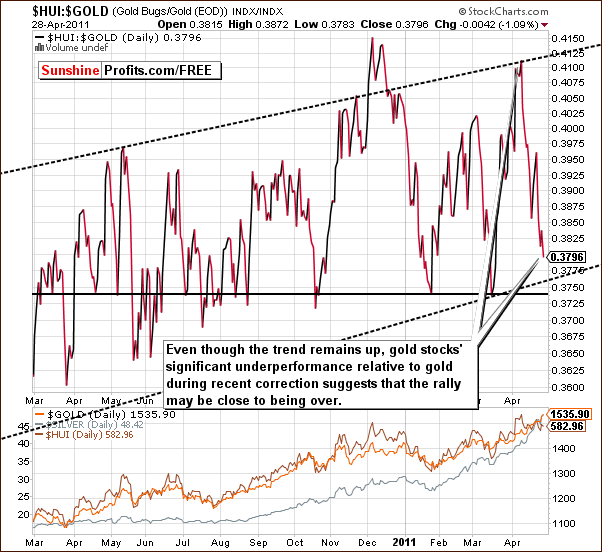Based on the April 29th, 2011 Premium Update. Visit our archives for more gold & silver articles.
In our previous essay (Golden Rally with a Silver Lining) we described the current situation in gold and silver and today we would like to provide you with a follow-up.
Sometimes, traditional technical (we dont view all of our methods as traditional, though) or fundamental analysis isnt enough to draw best conclusions in precious metals market; signals might be weak or contradictory, and sometimes. In all cases, its good to have some sort of confirmation. So, if we want additional information what would it be?
It seems that we already take into account everything as price is supposed to discount everything and since we generally analyze price charts then theres nothing left for us to do right? Not quite.
First we have to answer the question, what else matters when it comes to stocks? Again, according to Dow Theory, the price of stocks discounts everything (which means that every single information has influence on price), but we can draw some interesting conclusions from some bits of information more so than from others.
One of the most important factors is investors sentiment.
Emotions influence investors who very often decide due to their feelings rather than cold logic. Human psychology plays such a significant role in finance, that even a whole separate field in economics called Behavioral Finance was established. It tries to find how human will act in different situations in the market. Many rules of behavior have been researched and established. For example the same amount of money won or lost wont give us the same intensity of feelings. Losing a certain amount of money will cause us more upset than the happiness felt if we had won the exact same amount.
So, how do investors behave near the market peak?
When the price of gold rises news spreads quickly and the attention of many people focuses at that moment on gold. Everyone is hoping to make some profit, and they are convinced that gold is the best investment for them at the moment. They try to learn as much as they can about the reasons for the price increase and if there is still a possibility to make some money. They use various sources for their research: the Internet, newspapers, magazines, television, governments information, almost anything they can get their hands on.
If moods are exuberant, more and more people pile in to buy and the price keeps rising. Positive information emerges from the market, which encourage more investors to buy gold, which in turn causes the price to increase.
When the market is bullish, every single positive signal is magnified and prompts huge rises. Negative signals are often ignored, because everyone is thinking positive (by the way, how many analysts are currently ignoring the key fact that silver is very close to its 1980 high which is a major resistance level? There are quite many voices that focus on the short-term rally and completely lose the not-so-bullish long-term perspective).
Prices rise to the point where everyone that was interested is already in the market and there is no fresh capital flowing in. In that case the rally runs out of steam, stops, and then starts to decline. Drops can be dramatic because of speculators who sell their positions. This is the mechanism of how local tops are formed.
So how we can use that mechanism?
We can try to assess sentiment in the market. One of the useful tools is volume analysis, which shows us in fact if the analyzed asset is still popular among investors, or if investors stop buying this asset. However, the major drawback of the analysis of volume in this light is the fact that its money-weighted. If there was only one buyer than all the volume would be attributed to this particular buyer, not to the whole market. In other words, volume imprecisely measures the sentiment of the big guys and the problem here is that this group is does not correctly represent the whole market as far as sentiment is concerned. Investment advisors, market specialists perceive news and price movements differently than someone new to investing. The key point is that it is this someone new to investing that will act emotionally and whose emotions we want to somehow detect.
If we could somehow measure this sentiment, we would be able to predict tops with greater precision.
The good news is that Sunshine Profits has developed a special tool that can be used to measure sentiment of the average investor for the precious metals sector.
Please take a look below for details.

As you may see on the graph above, periods when gold reached its local top converge with periods of a very positive sentiment. The yellow line marks the average sentiment from the last 30 days. Notice that if Sentiment (marked by the green line) has significantly greater values, something interesting happens in the Gold Market in most cases a top is being formed. Look at peak in May/June 2006. Sentiment was way above its average, and what is more interesting, when Sentiment falls down immediately gold price dropped after a few days. There are many similar cases that you can spot on graphic. Pay attention to the last days and you may see that Sentiment is above Sentiment MA (average).
The most interesting fact is that Sentiment featured above (no, its not a transformation of the put-call ratio) peaks before the price does, and it appears to have already formed a top.
Without taking into account all other factors, relying only on sentiment analysis will not likely conclude really solid signals. Moving on, lets have a look at mining stocks and what do they have to talk on relative movements in gold.

In the HUI Index (proxy for gold stocks) chart, we clearly see a profound case of the underperformance of gold stocks relative to gold itself. This would not have been so bearish if the general stock market had also declined. This was not the case however stocks rallied.
So with golds price rising and stocks in general in an uptrend, the fact that gold stocks declined is clearly bearish. In addition, it is something that we have often seen in the past before important tops. This is, in fact, very much supporting our theory that we are close to an important top.

Before summarizing, look at the ratio between the gold mining stocks and gold itself. We can clearly see the underperformance of golds stocks in recent days without using this ratio, but a look at the chart of the ratio shows that the gold mining stocks underperformance is significant. Investors with holdings in gold at this time should be concerned with its medium-term rally in light of the poor performance seen recently for gold mining stocks.
Summing up, based on the analysis of sentiment and on the way mining stocks perform relative to the underlying metals, it appears that the end of this rally is quite close.
To make sure that you are notified once the new features are implemented, and get immediate access to my free thoughts on the market, including information not available publicly, we urge you to sign up for our free e-mail list. Sign up for our gold & silver mailing list today and you'll also get free, 7-day access to the Premium Sections on my website, including valuable tools and charts dedicated to serious PM Investors and Speculators. It's free and you may unsubscribe at any time.
Thank you for reading. Have a great weekend and profitable week!
P. Radomski
--
Our latest update includes a Previous Tops section where we dig deep into patterns seen right before previous major tops - clearly there are many similarities. The most important point is that there was a particular final exit signal that we've seen in both 2006 and 2008 - being aware of this signal right now appears invaluable.
Additionally, we have sent out an alert yesterday with precise target for gold. We encourage you to Subscribe to the Premium Service today and read the full version of our analysis right away.

